










As we kick off a new year of new resolutions, I encourage all of you to take time to strengthen your resolve around total human health for you and your employees.
ABC members constantly lead the industry on the care they show their employees. Not only do we want to send them home safe at the end of the shift, we also want them to live a healthy lifestyle and enjoy the abundance life has to offer through their careers and beyond. We must remember that an important part of building a culture of safety is holding and encouraging conversations with your team. Although these topics may be difficult or sensitive, developing a culture that supports open communication and trust can help to build the team, improve communication, and save lives.
ABC has always been a leader in the industry, and as part of a future enhancement to ABC’s coveted STEP world-class safety management system, we are excited to announce the Total Human Health Initiative (THHI)
Founded in 1989 as a safety benchmarking and improvement tool, STEP has evolved into a world-class safety management system that dramatically improves safety performance among participants regardless of company size or type of work. Participating ABC member firms measure their safety processes and policies on 25 key components through a detailed questionnaire with the goal of implementing or enhancing safety programs that reduce jobsite incidents. ABC recognizes its responsibility to raise the bar with regard to how total human health is approached and implemented; to that end, ABC is leading the paradigm shift within the industry to focus on this critical topic.
This critical link in our STEP program has been designed to help our members focus and improve the complete health,
wellness, and livelihood of their employees. The THHI program matrix and resources were designed to provide simple and effective means and methods to build and customize any program from basic to advanced regardless of the size of your organization.
MIND
HEART SPIRIT
BODY
Physical wellness promotes proper care of our bodies for optimal health and functioning. It encourages the balance of physical activity, nutrition, and sleep.
HEART
Emotional wellness is the ability to cope effectively with life and build satisfying relationships with others.
Michele Daugherty

ceo@abccentralflorida.org
407-628-2070
Incorporating the THHI into your company is a critical component of your recommitment to safety in the new year. ABC has built a toolkit for our members that provides opportunities for your team to build the concepts into your existing practices as you integrate them with your STEP participation each year. Implementing the recommended activities will help your company improve safety outcomes. The THHI toolkit is designed to be fully customizable to reflect your company’s needs and safety goals. Whether these tools and resources are new to your company, or you want to enhance your existing resources, the THHI toolkit can strengthen your company.
If you would like more information on the THHI toolkit, please contact training@abccentralflorida.org
Financial wellness is a feeling of satisfaction about your financial situation. Finances are a common stressor for people, so being able to minimize worry about this aspect of your life can enhance your overall wellness.
Intellectual wellness is when you recognize your unique talents to be creative and you seek out ways to use your knowledge and skills.
Occupational wellness is a sense of satisfaction with your choice of work. Occupational wellness involves balancing work and leisure time, building relationships with coworkers, and managing workplace stress.
Mental health refers to the cognitive aspect of health. Often mental health is linked to or includes emotional health, but mental health is more the functioning of the brain, while emotional health refers to the person’s mood often connected to their hormones. Mental healthcare affects the other dimensions of health.
An increase in mental health can come as a result of increased physical activity, and good mental health can then lead to an increase in self-esteem as mental performance improves.
Environmental wellness is related to the surroundings you occupy. This dimension of health connects your overall well-being to the health of your environment. Your environment, both your social and natural surroundings, can greatly impact how you feel.
SPIRIT
Spiritual wellness is related to your values and beliefs that help you find meaning and purpose in your life. Spiritual wellness may come from activities such as volunteering, self-reflection, meditation, prayer, or spending time in nature.
Social (Community) wellness is a sense of connectedness and belonging. The social dimension of health involves creating and maintaining a healthy support network.
 PRESIDENT & CEO
The THHI has four easy-to-remember categories: BODY, HEART, MIND, and SPIRIT
PRESIDENT & CEO
The THHI has four easy-to-remember categories: BODY, HEART, MIND, and SPIRIT


PRESIDENT & CEO
Michele Daugherty ceo@abccentralflorida.org
VICE PRESIDENT & COO
Nancy Wray vp@abccentralflorida.org
MARKETING
Alssa Mathews communications@abccentralflorida.org
MEMBERSHIP
Catherine Wert membership@abccentralflorida.org
MEETINGS & EVENTS
Taylor Tidwell events@abccentralflorida.org
Eva Pardo meetings@abccentralflorida.org
TRAINING & DEVELOPMENT
Corey Schoenfelder training@abccentralflorida.org
CHAPTER SERVICES/ GOVERNMENT AFFAIRS
Taylor Dupree info@abccentralflorida.org
ACCOUNTING
Francine Conway accounting@abccentralflorida.org
facebook.com/CFABC/ linkedin.com/company/central-floridachapter-associated-builders-andcontractors-inc./
@CentralFLABC
BUILDING Central Florida Magazine

For more information Alssa Mathews, Marketing and Communications Manager at 407-628-2070 or email bcf@abccentralflorida.org
Website/Media Kit: abccentralflorida.com/media/building-central-florida/ Store/Reservations: abccentralflorida.com/product/bcf-magazine/
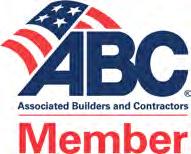
Adams Group
Michael Hornung
2221 Murphy Court
North Port, FL 34289
(941) 639-7188
mhornung@discoveradams.com
www.discoveradams.com
Architectural casework & millwork, etc.
Subcontractor: $1M-$3M
Sponsor: Juan Garcia, Wade Brooks
CMC Rebar
Larry Brace 1755 Avanue A
Kissimmee, FL 34758 (407) 935-0123 larry.brace@cmc.com
www.cmc.com
Rebar fabrication
Supplier Member
Sponsor: Michael Jordan
Coastal Painting Company
Ben Vendette
6301 NW 5th Way, Suite 1200
Pompano Beach, FL 33073
(954) 427-1994
bvendette@coastalpaintingfl.com
www.coastalpaintingcompany.com
Painting and wall covering
Subcontractor: $1M-$3M
Sponsor: Jonathan Pearch
ECRS - East Coast Rigging & Scaffolding of Florida
Joel Ross
3130 NW 17th Street
Fort Lauderdale, FL 33311
(954) 616-8487
jross@ecrscaffold.com
www.eastcoastrigging.com
Scaffolding erection & dismantle, temporary shoring, scaffolding, etc.
Subcontractor : $1M-$3M
Hanson Construction, Inc.
Tony Hanson
1201 Fairview Avenue
Winter Park, FL 32789
(407) 951-8223
thanson@hansongc.com
www.hansongc.com
General Contractor: $10M-$15M
Sponsor: Chad Tinetti
Helicon
Steve Wightman
4260 Church Street, Suite 1340
Sanford, FL 32771
(321) 455-8007
steve.wightman@heliconusa.com
www.heliconusa.com
Deep foundation systems & soil stabilization
Subcontractor: $3M-$6M
Kelsie’s Blinds Inc.
Eric Stapp
2464 West State Road 426 Suite 1028
Oviedo, FL 32765 (407) 977-0827
estapp@kelsiesblinds.com
www.orlandoblinds.com
Window covering contractor
Subcontractor: $1M-$3M
Sponsor: Oskar Torres
Liberty Investment Properties, Inc.
Jennifer Bollhofer 824 Highland Avenue Orlando, FL 32803 (407) 774-8818
jbollhofer@libertyprop.com
www.libertyprop.com
Owner/Developer
Associate Member
Sponsor: Tim Keating
Mad Systems, Inc.
Toni Losier 733 North Main Street Orange, CA 92868 (407) 929-0956
toni@madsystems.com
www.madsystems.com
AudioVisual & interactive designer and integrator specializing in exhibits
Subcontractor: Under $1M
Sponsor: Justin Stehr
Midstate Caulking & Construction Services, LLC
Brenda Clement 1600 Kelley Avenue
Kissimmee, FL 34744 (407) 350-5958
bclement@midstatecaulking.com
www.midstatecaulking.com
Caulking, waterproofing, stucco, EIFS, etc.
Subcontractor: $15M-$20M
Sponsor: Wade Brooks, Scott Scruby
Miller Electric Company
Tony Staiano
528 Northlake Boulevard Suite 1024
Altamonte Springs, FL 32701
(407) 328-5220
tstaiano@mecojax.com
www.mecojax.com
Electrical contractor
Subcontractor: Over $250M
Sponsor: Scott Scruby, Brian Butler
Noble Construction Group FL
Blanca Padilla
330 N Beaumont Avenue
Kissimmee, FL 34741 (407) 750-9300
bpadilla@skyviewcompanies.com
www.mecojax.com
Owner/Developer
Associate Member
Sponsor: Willis Milner
Oelrich Construction, Inc.
Amanda-Gaye Smith 428 S. Dillard Street Suite 103
Winter Garden, FL 34787 (352) 745-7877
agaye@oelrichconstruction.com
www.oelrichconstruction.com
General Contractor: $20-$50M
Sponsor: Chris Evans
Owen Electric Company, Inc.
Justin Lee 774 Northlake Boulevard
Altamonte Springs, FL 32714 (407) 790-7094
jlee@owenec.com
www.owenec.com
Electrical contractor
Subcontractor: $20-$50M
Sponsor: Juan Garcia, Wade Brooks
Quinco Electrical, Inc.
Kara Dale 4224 Metric Drive
Winter Park, FL 32792 (407) 857-6133
kara@quincoelectrical.com
www.quincoelectrical.com
Electrical contractor
Subcontractor: $20-$50M
Sponsor: Chris Evans
Burns McDonnell
Fernanda Lopes
2301 Maitland Center Parkway
Suite 400
Maitland, FL 32751 (321) 280-5810
flopes@burnsmcd.com
www.burnsmcd.com
General Contractor: $1-$3M
Sponsor: Ben Goodin, Joe Orr
Rollins College - Facilities Services
Jenn Annan 1000 Holt Avenue
Mailbox 2732 Winter Park, FL 32789 (407) 691-1000
jannan@rollins.edu
www.rollins.edu
Owner/Developer
Sponsor: Daniel Kemack, Adrian Galvan
Sea Can, LLC
Garett Gauthier
10600 South Orange Avenue Orlando, FL 32824 (407) 743-5600
gg@seacanfl.com
www.seacanfl.com
Site storage containers
Supplier Member
Sponsor: Daniel Kemack, Adrian Galvan
SmartBuild
Zulq Malik 28 Westwyn Court Suite 4
Brampton, Canada L6T 4T5 (888) 403-0421
zmalik@smrtbld.com
www.smrtbld.com
Construction management software Associate Member
Superior Rigging & Erecting Co.
Fred Metz
11244 Boggy Creek Road Orlando, FL 32824 (407) 730-8886
f.metz@superiorrigging.com
www.superiorrigging.com
Heavy equipment rental, heavy hauling, rigging, steel fabrication, warehousing
Subcontractor: $3M-$6M
Sponsor: Willis Milner
Request
logorequests@abccentralflorida.org
Speculation about a recession is running high, with some calling for construction contractors to start preparing for a slump that could begin any day and last well into 2023. But what should companies do if they want to heed this advice?
Newly published academic research offers a roadmap by highlighting some of the most effective strategies for preparing for and coping with an economic crunch, based on nationwide research that elicited responses from 61 construction financial officers, CPAs and sureties based in the United States.
The lead author of the research,“U.S. Construction Industry Managerial Strategies for Economic Recession and Recovery: A Delphi Study,” Manideep Tummalapudi, is an assistant professor of construction management at California State University, Fresno.
Tummalapudi and his coauthors investigated construction economic and financial experts with an average of 25 years of experience to rank a total of 40 potential strategies. Having experienced economic downturns before, these industry veterans were well-positioned to judge the effectiveness of different approaches to preparing for or coping with economic volatility.
The research was conducted in phases beginning in 2019. In reaching out to construction final experts, CPAs and sureties all over the United States, Tummalapudi’s goal was to produce “a roadmap of economic, managerial and financial strategies that can be implemented by construction companies to improve their financial health during different economic cycles.”
Initially, the researchers worked with the construction experts to identify more than 65 strategies that had helped them successfully navigate previous recessions. These fell into six basic categories:
1. organizational and project management;
2. direct-cost;
3. overhead;
4. financial;
5. preconstruction and marketing; and
6. efficiency.
The same experts used a 100-point scale to rate these recession strategies. They achieved consensus on 41 and classified as either “highly effective” (nine strategies) or “moderately effective” (32 strategies). For a strategy to count as highly effective, at least 80%
needed to give it a score of 80 or higher. In addition, the experts could flesh out numerical ratings by submitting written remarks.
The nine strategy descriptions that received that “highly effective” ranking fell into three categories: organizational and project management, overhead and financial. In the first of those three categories, the strategies rated as highly effective were: “Use previous successful planning to design a sound business financial plan focused on cash flow and operational efficiency” (mean score: 85.7) and “The company should always be looking for sound, more efficient, more profitable practices and strategies” (86.9). In the overhead category, the two strategies earning the highest designation were: “Prior to and during the recession, build a company culture to reassure employees they are valued despite cuts” (90) and “If there are sacrifices to be made (i.e., pay, bonuses, staffing, etc.) during a recession, the owners of the company should participate to the full extent that they ask their employees to participate” (88.7).

The financial category had the largest number of highly effective strategies—a total of five. They included the following.
1. “Establish strong cash reserves prior to the economic downturn. Retain profit in the company during good times; it helps the firm survive during downturn times. Retain capital to support the business during a downturn.” (93.4)
2. “Focus on cash flow.” (93.4)
3. “During the recession, maintain a healthy balance sheet with strong liquidity, sufficient equity, strong working capital and manageable debt load.” (93.8)
4. “During the recession, focus on profits, not volume. Know your breakeven point continually and generate bottom-line profit.” (90.9)
5. “Have a bank line of credit established and do what is necessary to maintain it in good standing with the bank.” (89)
The CPAs, financial officers and sureties were nearly unanimous on the importance of retaining profits during good times to cover salaries and other operational costs when the economy tanks. Other advice included maintaining access to a bank line of credit and limiting indebtedness: “A balance sheet with limited debt, ability to restructure loans and a strong cash position allows for greater
Continued on page 28
With
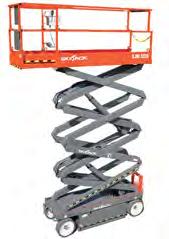
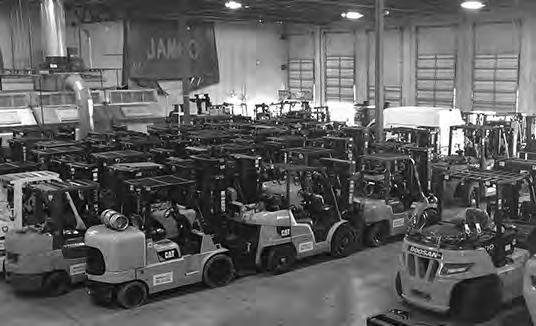



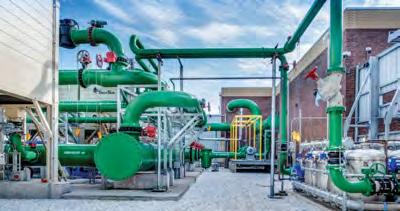
2023 BOARD OF DIRECTORS OFFICERS
Carlos Velasco | Chair
Acousti Engineering Company of FL
Julie Holmes | Chair-Elect
JK2 Scenic
Thomas Wert | Vice Chair
Dean Mead Attorneys at Law
Juan Garcia | Vice Chair
PCL Construction Services, Inc.
Roy L. Burkett | Vice Chair
S. I. Goldman Company, Inc.
Chris Evans | Immediate Past Chair Brasfield & Gorrie, LLC
2023 BOARD ADVISORS
Ray Bastin, CPA | Treasurer Withum
Michael C. Sasso | General Counsel
Sasso and Sasso, P.A.
2023 DIRECTORS
Jason Albu
Albu & Associates, Inc.
Charles Bracco
Modern Plumbing Industries, Inc.
Kevin Bradford
Charles Perry Partners, Inc.
Roxana Hernandez
Turner Construction
C. L. Janeski
Tri-City Electrical Contractors, Inc.
Michael Jordan
Universal Forming, Inc.
John Kurtz
Gilbane Building Company
Earl Lomas
Terry’s Electric, Inc.
Willis Milner
Balfour Beatty
Debbie Rodriguez
Competitive Edge Partners & Consulting, LLC
David Schultz
CEMEX
Scott Scruby
Sunbelt Rentals
Jonathan Sheppeard
Austin Commercial, LP
John Smalley
Hensel Phelps
Chad Tinetti
Tavistock Development Company
Oskar Torres
Towers Construction Company
Derrick M. Valkenburg
Shutts & Bowen, LLP
Matthew Walton
MiGre Engineers, LLC
PRESIDENT & CEO
Michele Daugherty
ceo@abccentralflorida.org
Michele Daugherty, President & CEO interviewed Carlos Velasco, Vice-President of Construction, Florida, incoming 2023 Central Florida ABC Board of Directors Chair.
How did you get your start?
After graduation from college in 2000 I moved to Orlando, FL where Acousti Engineering gave me the opportunity to start working for them in the field as an apprentice. I had no previous construction experience but was willing to learn any trade and the company was willing to provide the training required to become a journeyman. I had the opportunity to work in metal framing, drywall, and ceilings. After a few years in the field, I realized I wanted to grow so I joined the apprenticeship program. There, I was also educated on blueprint reading and estimating while maintaining my full-time job in the field. Shortly after, I joined the office team where I was able to work in multiple departments and be promoted to my current position.
Give me one word that describes you the best. Determined.
What are your goals?
My goals are to serve others, on a personal and a professional level; I have always enjoyed helping others, it has been part of my life since I was a kid. Another goal is to see my children grow older and be their support for as long as I can do it! Also, to successfully fulfill the role as the chairman of the board for 2023.
What are your three biggest accomplishments?
1. Becoming a husband and father and seeing how the hard work and dedication has reflected on my children’s personalities and success.
2. I came as an immigrant to this Country, so I am very proud of becoming a US Citizen and contributing as a member of our community.
3. Becoming a leader in my organization and knowing that I am appreciated and respected among our employees, family, and friends.
What’s been your most meaningful project?
Very difficult question as I feel each job I have completed, had its own challenges and rewards simultaneously. If I had to pick one, I would say the FAMU College of Law Downtown Orlando, it was my first big job as a rookie project manager where I had to prove myself. It was a complicated job for me however, despite its challenges, it was completed successfully.
Who is a person that you considered a role model early in your life? How and why does this person impact your life? My work ethic comes from my father, so he was and will always be my role model. Thanks to his wisdom and fatherhood, he made me who I am today by teaching that hard work pays off, not to take anything for granted and to be respectful to others no matter what. My father’s goal was to raise me as a good faithful, hardworking, and educated person, and I feel he accomplished that and more.
What do you hope to achieve in 2023 as ABC Central Florida Chair?
As the 2023 Chair I want to deliver a clear message to our members and future members of what ABC stands for, our core values and mission. I would like to see our training programs grow and provide more opportunities for our members to develop their employees with our guidance. Finally, additional committee involvement across the board. I would like to team up with other ABC Chapters to improve their performances as well as mimic and learn from them to increase our membership and become Top Performing Chapter overall.
Tell me about yourself.
I was born and raised in Bucaramanga, Colombia, and grew up in a family of six. I went to a Catholic school in my hometown, then I graduated with a bachelor’s degree in business administration back in June of 2000. My father was an entrepreneur and while attending college I worked for him. I worked in the field for three years at Acousti until I was given the opportunity to move to the office. After a few years working as project manager, branch manager and regional manager, I was promoted to VP of construction for region #3 in 2022. I have a beautiful wife and two teenage children in their junior and senior years at Bishop Moore. I enjoy playing golf, traveling, and riding motorcycles.
What are the most important decisions that you face daily as a leader in your organization?
Our employees are an essential part of our daily operations, so we must make sure they have the resources they need to succeed. It is important not only to know their needs when executing a project but also to listen to their problems, concerns, and ideas; it is part of the daily interaction. Keeping them motivated and appreciated is paramount for us.
What is most important to you and your organization – mission, vision, or core values? Why?
Our employees! We love what we do and the people we do it with. They are the core of what we do, without them we could not fulfill our obligations and commitment to become the number one interior specialty contractor in the Southeast. Thanks to their skill set we can achieve the highest standard of installation. In addition, our clients, our goal is to build a lasting relationship with each of them. We take pride in our longstanding relationships that have been built by exceeding expectations with first class workmanship and quality construction materials which brings repetitive business. Without our customers, we would be incapable of accomplishing our dreams.
What advice would you give a new employee going into a leadership position for the first time?
Listen, ask and communicate.
What is the most important characteristic that every leader should possess?
A good leader should be able to listen to others and understand their challenges, concerns, and ideas. A leader should create opportunities for others to grow and provide the tools and resources they need to become great leaders.
What are your favorite questions to ask those you lead?
How can I help? What do you need? What’s the problem? What solutions can you offer to correct the problem?
What are the keys to developing the next generation of leaders in your world?
Provide the proper and adequate training, getting them to engage in the decision-making process, encouraging them to create positive change and listening to their ideas.
What questions are you asking yourself lately?
Am I being a role model for my family? Are our employees happy? What can I do better as a person, so I provide a positive impact to the people that surround me?
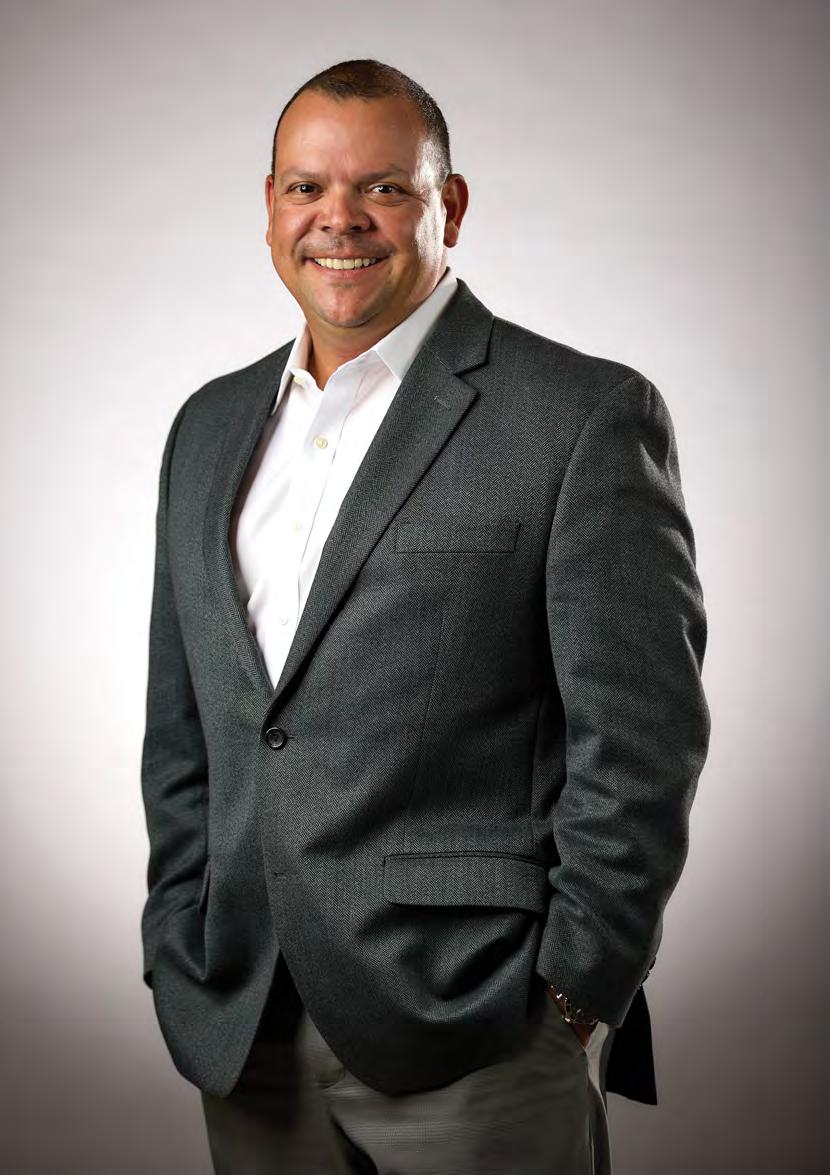
What’s your best business advice?
Deliver results by keeping your word and communicate openly to deliver the service you promised.
Our jobs demand many hours of work and dedication, long days and sometimes weekends, while being responsible and keeping business running, I strive to keep a balance between family and work. I make sure to answer their calls and spend time with them whenever we can. I try not to bring my work concerns home and instead ask about how they feel, what is bothering them, and to the best of my capability, provide helpful advice when needed. Spending time outside work with them traveling, playing sports, or enjoying outdoor activities that bring us together as a family.
What do you do to take care of your employees?
We offer training, which provides an opportunity to grow financially and professionally. We care for our employees and what they represent to us; this is a business driven by relationships and most importantly our field employees that perform the work, without them we could not complete so many successful projects in the last 76 years. We want to make sure they feel at home, acknowledged, and appreciated.
 By John Crichton, Chris Perruna and Rob Olivet
By John Crichton, Chris Perruna and Rob Olivet
As the workplace industry adapts further to post-COVID-19 norms, corporate headquarters are shifting to designs that do more than deliver operational performance and efficiency. The ability to attract and retain top talent has become a primary focus, especially as hybrid working remains the norm and employers are trying to find ways to make remote workers want to spend more time in person with colleagues. One of the ways office design and construction is accomplishing this is to ensure that spaces embody the culture, diversity, sustainability, collaboration, wellness and technology-forward principles that employees increasingly say they want in employers of choice.
There is a central paradox at the heart of today’s office: creating a place where people want to be, inherently means it also needs to be a space they can be away from without missing a beat. This isn’t a simple task, as companies must align technology and built environments that can empower geographically distributed teams and still bring people back physically. A recent study conducted by the Centers for Disease Control and Prevention (CDC) found that work flexibility is expected to be an increasingly significant contributor to worker well-being in the future, and coupled with wellness, remain top of mind for company culture. To incorporate this successfully requires more than HR policies; it requires spaces engineered to ensure people can balance life and work without employers losing a step in the market. Importantly, companies also need to accomplish this sustainably, not only because it’s the right thing to do, but because employees say they want to work for companies that do the right thing. This all starts with projects that create their work environments.
According to BOMA International, corporate build-out and renovation projects now need to balance maximizing the utility of each square foot with simultaneously creating a compelling destination that includes a variety of spaces and amenities focused on wellness and productivity. Recent additions to headquarters projects feature spaces like daycare facilities, barber shops and salons, gyms, pet-friendly amenities, eco-friendly living ‘green’ walls,
bike shops, wellness areas, prayer rooms, EV charging stations and outdoor walking paths so that employees can address their personal to-dos, mental health and wellness activities within their work environments. These elements are key drivers in bringing the workforce back to the office in a post-COVID-19 environment.
According to a recent Ambius survey, 93% of Americans want companies to invest more in healthy indoor environments. Among the key improvements to headquarters that employees look for are air quality, hygiene and natural design elements. These new expectations will be a driving force behind the future of design for indoor spaces. In other words, even at work, there needs to be seamless opportunities to be away from one’s inbox.
“Seamless” is an operative word, as it’s not enough just to have cool spaces; experiences need to be engineered to reduce friction in ways that make offices feel worth the time lost in commuting. Companies also need to plan and build for today’s (and likely tomorrow’s) hybrid reality, including, for example, collaboration rooms with top-notch audio-visual systems to easily integrate remote and in-person workers and experiences—as well as digital connectivity, remote access control and speed to avoid too much time spent asking “Can you see or hear me?” The Harvard Business Review says that “In human moments people are often energized and more likely to empathize with each other, which supports organizational culture and collaboration” and that when communication takes place remotely “the connection is severely weakened.”
By bringing together what is important to both employees and the goals of the organization as a whole, the corporate headquarters can be a well-rounded strategic enabler of organizational success. By thinking ahead, continuing to remain flexible and mitigating any potential stresses, both the workplace and in-office teams can continue to thrive because they instill a sense of freedom and wellbeing that benefits both the employees and the company.






CareerSource Central Florida (CSCF) is Central Florida’s leading workforce development board dedicated to providing comprehensive and complimentary career services to career seekers and works diligently to provide local businesses with strong talent, valuable resources and engaging opportunities. Businesses across Central Florida have found a partner in CSCF to support their hiring & recruit ing needs, training and provide workforce solutions to address challenging situations in the workplace.
CSCF develops programs and initiatives to strengthen the workforce in the community and understands the challenges and disruption brought by the COVID-19 pandemic. Work places faced new challenges; employees’ mindsets changed and demanded better pay, ben efits, and flexibility. Employers were forced to understand the new demands, evaluate their workplace cultures, and consid er innovative ways to support and prioritize the health and well-being of their employees.
While businesses focused on adjusting their practices to meet the labor mar ket demands a more significant challenge impacting both employers and employees accelerated during the pandemic: opioid crisis.
According to the latest statistics by the Centers for Disease Control and Prevention (CDC), more than 107,000 Americans died of an overdose in the 12 months ending in March 2022 – The highest number of overdose deaths ever recorded in 12 months. In Central Florida, between January and June 2020, 292 people died of a drug overdose. Compared to the same time period in 2019, 209 people died of a drug overdose, representing a 40% increase in deaths.

Research by the National Institute for Occupational Safety & Health, revealed that construction workers have higher rates of death from an overdose compared to
workers in other occupations. The higher rates are tied to Injuries in the workplace
CareerSource Central Florida launched “Fostering Opioid Recovery through Training & Employment” (FORTE) together with Project Opioid – a four-year initiative that has to date, reached over 1,000 Central Florida businesses and individuals.
Along with Project Opioid, International Center for Addiction and Recovery Education (ICARE), Advanced Recovery Systems (ARS), Greater Orlando Society for Human Resources Management (GOSHRM), and others are seamlessly working to provide training, certifications, and educational offerings to local employers. These efforts equip HR professionals with skills and tools to support current employees and potential new candidates impacted by opioid addiction along their recovery journey to return to the workplace.
states that around 15% of all constructions workers in the United States have a substance use disorder compared to 8.6% of the general population of adults. In addition, construction workers represent about 25% of fatal opioid overdose among all workers.
What role does a workforce development board such as CareerSource Central Florida plays in helping businesses combat the crisis? The answer is simple: provide workforce solutions to HR professionals and employers to help support and integrate individuals recovering from opioid addiction into the local workforce.
In 2020, CSCF received $2.7M from the state of Florida to bring awareness to the opioid crisis and provide crucial training to businesses to aid job seekers and workers who have been impacted by opioid addiction. Utilizing funds from the grant,
According to the National Safety , 75% of employers have been directly impacted by opioids, but only 17% felt well-prepared to handle the situation. Not addressing this issue can lead to loss of productivity, absenteeism, low morale, turnover and more. This initiative presents an opportunity to originate a dialogue that fosters opioid recovery through workforce solutions. Businesses can learn ways to destigmatize substance abuse disorder and opioid use disorder and support employees in the workplace while creating a recovery-friendly organization.
CSCF is ready to be part of the solution and support businesses on the path to become a recovery-friendly organization. Register for an upcoming Naloxone (NARCAN) training course or the Certified Facilitator in Addition Awareness –Human Resources (CFAA-HR) starting in March 2023, a national Society for Human Resources Management (SHRM) Pinnacle award winning training.
For more information on how businesses can engage with and benefit from FORTE, please visit CareerSourceCentralFlorida. com/forte


 By Emily Kirby, BPH, and L. Casey Chosewood, MD, MPH
By Emily Kirby, BPH, and L. Casey Chosewood, MD, MPH
U.S. Surgeon General, Vice Admiral Vivek H. Murthy, MD, MBA, participated in a fireside chat on the final day of the 3rd International Symposium to Advance Total Worker Health®. Dr. Murthy joined Dr. L. Casey Chosewood, Director of the NIOSH Total Worker Health (TWH) Program, for a conversation about protecting and promoting worker safety, health, and well-being.
The fireside chat began with an overview of the broader mental health crisis in the U.S. Dr. Murthy described disturbing trends in anxiety, depression, loneliness, and deaths by suicide seen across age groups. He stated that on average, it takes young people 11 years to seek care after first experiencing mental health symptoms. With the substantial amount of time we spend at work, Dr. Murthy noted that the days of ‘checking our baggage at the door’ when coming to and leaving work are long over. He emphasized the reality that work affects mental health, in and outside of the workplace. Workplaces that prioritize their workers’ mental health can help increase their productivity, creativity, and retention. Though this is not an issue exclusive to the pandemic, he noted, recent events led workers to consider what they want out of the workplace and what they are willing to sacrifice. Workplace efforts to protect and improve workers’ mental health are an investment that will pay off for workers and organizations.
In response to the next question, Dr. Murthy described how workplaces can help achieve our goal of making mental health and well-being accessible to every worker regardless of where they work. This is not a goal that workplaces can achieve alone but we can start by prioritizing and supplying resources to all levels of an organization, not just human resources professionals. In his work studying the trends known as the “great resignation” and “quiet quitting,” Dr. Murthy found that workers consistently say they want to feel:
Safe: Occupational safety and health professionals know that safety is critical but not everyone experiences this in the workplace. For example, 80% of health care workers reported being verbally or physically attacked during the pandemic. Valued: Workers want to know that they matter and their work matters. Sometimes we assume that people know this, but we must overcommunicate it to make sure workers feel appreciated. Supported: Strong support from leadership and colleagues has profound benefits on workers’ mental health and well-being. Dr. Murthy shared a story of his own experience during a difficult time working as a resident when support from leadership, administrative officials, and coworkers helped show him he wasn’t alone.
The subject of confronting health worker burnout is an incredibly important issue to the U.S. and to Dr. Murthy per-
sonally. Workers from across all aspects of health care, like nurses, doctors, public health workers, and more, worked throughout the pandemic putting others before themselves. These sacrifices continue to take a physical and mental toll on workers, some of whom were subject to attacks and lacked protections at work. However, burnout was an issue before the pandemic. Dr. Murthy’s team recently released an advisory to raise public awareness, emphasizing that this crisis affects everyone and that we can all play a role in addressing it. For example, health care systems can create safer environments and provide better access to mental health services. In the workplace, in communities, and as patients, we can all show appreciation and gratitude to these workers at every opportunity, not just during the pandemic. These workers face long hours, workplace hazards, and often endure administrative burdens such as prior authorizations or tedious record-keeping, which keeps them in front of screens instead of hands-on with patients. Learn more about NIOSH efforts to protect health worker mental health.
Dr. Murthy also recognized that many other workers are experiencing burnout, especially essential workers who helped society continue to function during the pandemic. This work took its toll. Dr. Murthy discussed the lag between an immediate stressor, like a hurricane or another emergency event, and the timing of when mental health symptoms show up. He emphasized burnout as a workplace phenomenon, not caused by an individuals’ mental health status but as a byproduct of workplace issues. Workers may be in environments without a sense of connection or support, may be asked to do more than time or resources allow, and may experience discrimination or a toxic environment, all leading to burnout. It is critical to ensure that mental health resources are available to workers as we continue to see different manifestations, like depression and burnout. Supportive policies are crucial to ensure workers have access to care, including insurance that covers accessible services.
However, a possible silver lining of the tremendous costs of the pandemic is that, as Dr. Murthy noted, it provides an opportunity to rethink healthy work. We can design workplace environments that support mental health and well-being, where people feel more connected. This doesn’t necessarily require funding for workplaces to accomplish, but it does require commitment. Leadership can demonstrate their commitment to mental health and well-being by talking about these issues with workers and providing access to counselors and care. Perhaps more importantly, we can use this momentum to make sustainable changes in workplace policies, practices, and programs.
For more information, visit twhsociety.org blogs.cdc.gov/niosh-science-blog/

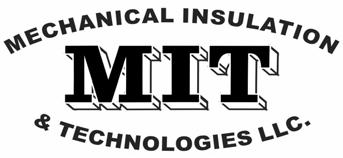










It was early 2021 when Orlando Mayor Buddy Dyer and District 5 Commissioner Regina Hill were joined by leadership from The Collage Companies, other members of the Orlando City Council, and its development partner, Creative Village Development, LLC to break ground on Luminary Green Park at Creative Village. Fast forward to November of 2022 and the city held a grand opening event where more than 100 city employees as well as workers at EA, UCF, Valencia, and other businesses were on hand. For the event, a giant video board affixed to the EA building played footage from its Madden 23 video game, which was released the same month – which enforces the creative technology-forward image of the community.
Creative Village is touted as Orlando’s digital media and education center of the future and the City of Orlando’s 2.3-acre Luminary Green Park will shine a light on some of Orlando’s luminaries. The Collage Companies served as general contractor for the project working with JCB Construction, Cornerstone Construction, Sentry Electric, Florida Fence Products, Brilliant Manufacturing, and many other subcontractors and vendors.
The unique community space is surrounded by apartments, UCF and Valencia College’s joint downtown campus, and Electronic Arts’ new studio. The park’s premium iconic features are the pre-cast concrete “ORLANDO” letters sitting in front of the massive white aluminum trellis. The park boasts a large open lawn space, with meandering concrete paths illuminated
with a variety of specialty LED light fixtures. In early 2023, the City of Orlando will unveil one dozen “Luminary Markers” which posthumously honor community trailblazers and neighborhood leaders. The “Luminary Markers”, designed by AOA, a local Winter Park specialty design firm, are constructed of solid aluminum panels etched with a custom design and are internally lit with multiple LED fixtures. The south end of the park hosts a specialty plaza dubbed the “Keystone”. This plaza is designed to replicate the concrete plaza that once graced the old Amway Center that previously occupied the park’s grounds.
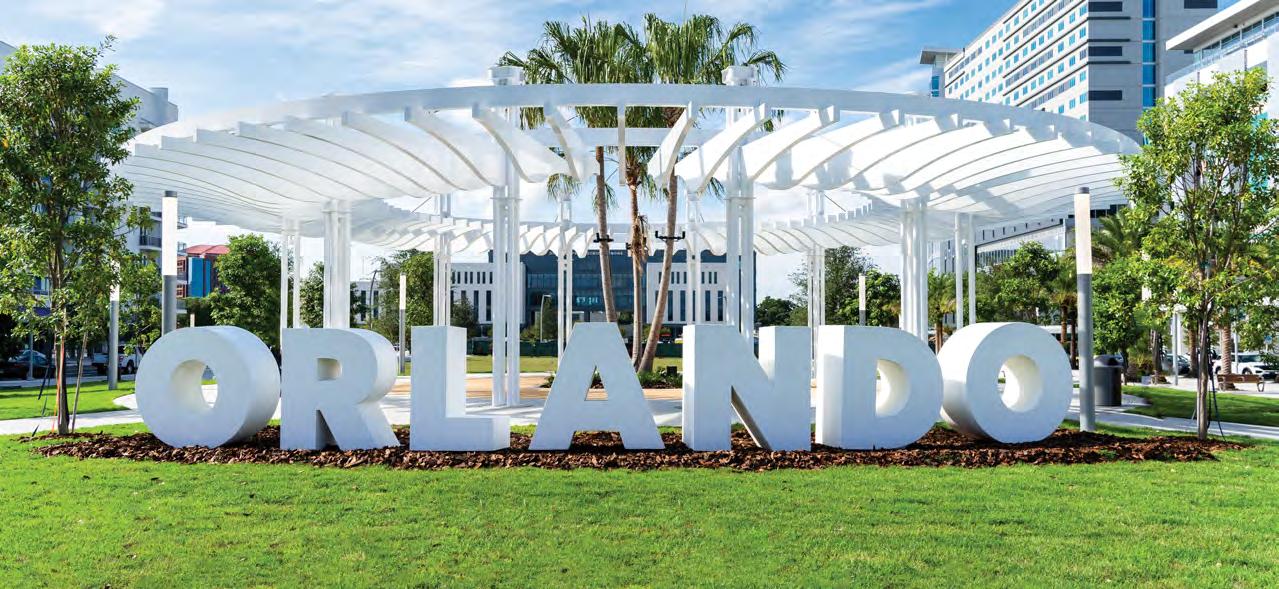
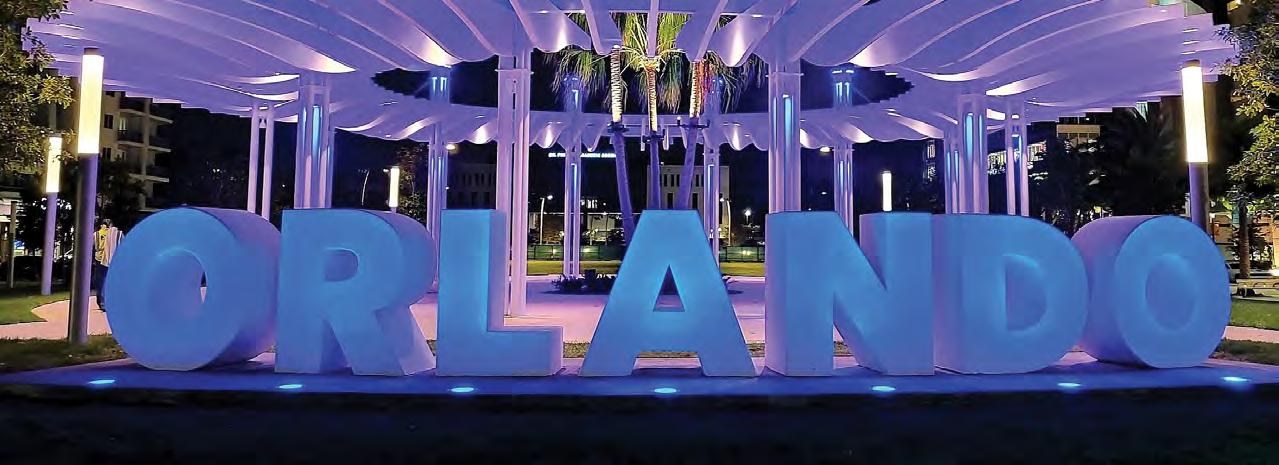
“Luminary Green Park at Creative Village is a unique and special gathering space we created for residents, professionals and students that serves as a signature park in downtown for generations to come,” said Orlando Mayor Buddy Dyer.
“Most exciting is how we posthumously honor individuals as Luminaries at the park for their service to the Parramore-Callahan community.
Congratulations to The Collage Companies on 40 years of building in Central Florida and to the team who helped make this vision a reality.”


The Cocoa Beach Police Headquarters has been on the City’s wish list for over 16 years. Originally proposed in 2004, the need grew so great, that the city could no longer delay the project. With a force of more than 90 members consisting of 39 sworn officers, telecommunicators, beach rangers, parking enforcement specialists, and civilian personnel, it was time to finally pull the trigger.
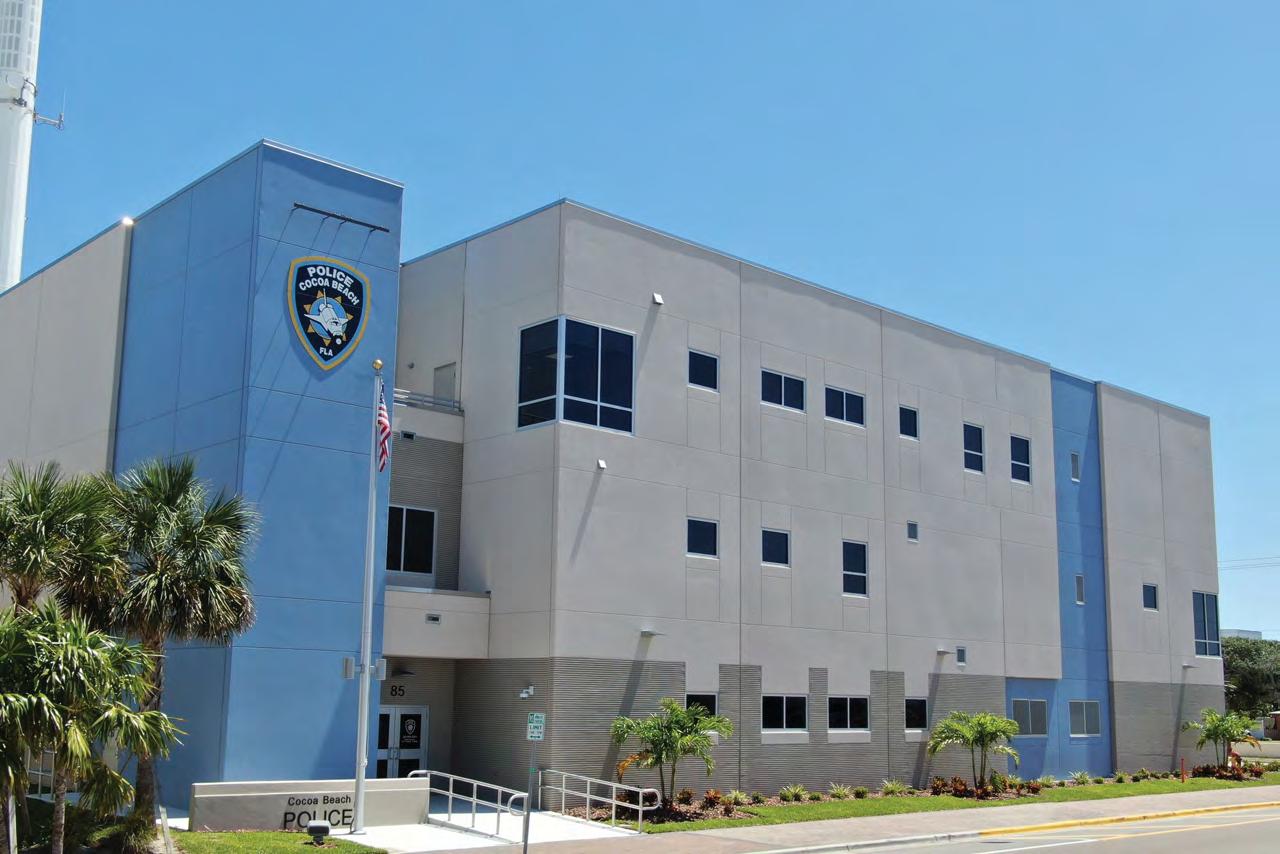
Through a design-build partnership, H. J. High was engaged along with Harvard Jolly Architecture to design and build the new facility. Since it was to be built in a coastal community and a block from the beach, there were very specific needs to be fulfilled from a structural standpoint. In addition, as in any police facility, there were also numerous programming benchmarks that had to be incorporated as well.
The headquarters is a state-of-the-art, tilt-wall, hardened facility, designed and built to withstand category five hurricane winds and rains. It will be able to withstand severe storm surge and maintain functions as an emergency operations center during times of crisis. Upgraded infrastructure and communication technologies allow for quicker, more efficient responses and allow the department to adapt to new and ever-changing requirements.
The facility includes a variety of spaces essential to a 21st century Police headquarters including: public and secured parking, security gates with access control, personal property storage, evidence storage, break and conference rooms, weapons storage, administration offices, K-9 facilities, detention cells, records, interview rooms, a communications center, and a physical agility/defensive tactics room. The physical fitness/agility room was a non-negotiable requirement for the building. The police chief, Scott Rosenfeld, is an avid supporter of physical fitness and wanted to provide his team a place to stay in shape. Affectionately known as “Chief Rosie,” the gym is adorned with a custom made sign that reads “Rosie’s Gym.”

At three stories, the building was designed so that all critical operations were placed on the second and third floors. This would allow the
but still not disrupt the building’s
during an
Several ABC member companies participated in the construction and made the overall project a success. The project site, often referred to as “a postage stamp,” was quite small and there was no additional area for laydown. So subcontractors had to be carefully coordinated to ensure that the specific trades were onsite precisely at their specified window.
Fabco Metal Products provided the structural steel. They were very deliberate about deliveries because there was no storage onsite and steel had to be flown into place as it was delivered.
Hudson-Everly Commercial flooring provided all the tile and LVT.

SMI Cabinetry provided millwork that had a bullet-proof rating at specific areas within the building.
Sutter Roofing provided the light-weight insulated concrete roofing and roof pavers.
VMG Construction provided the tilt-panels and the site concrete and really stole the show. Due to the small footprint of the site, there was no room to pour tilt panels, so they stacked the panels up to five high. Placement of the panels was critical because they had to be erected in a very specific order. So the earliest flown panels had to be on top. In addition, we had to coordinate the delivery of a very large crane that took 14 tractor trailer loads and shut down of a city street for an entire day.
The Cocoa Beach Police Headquarters has come to be known as “The Unicorn” around the H. J. High office. It was one of those rare projects that came together with very few surprises and is a testament to the entire team that was involved. The project was delivered under budget and any client driven changes were paid for through buyout savings. Additionally, the project was delivered a month early. It also was the recipient of three awards: The ABC Excellence in Construction Award of Merit, The Design-Build Institute of America – Florida Chapter Project Federal, State, County, Municipal Project of the Year, and the overall Project of the Year for the State of Florida.

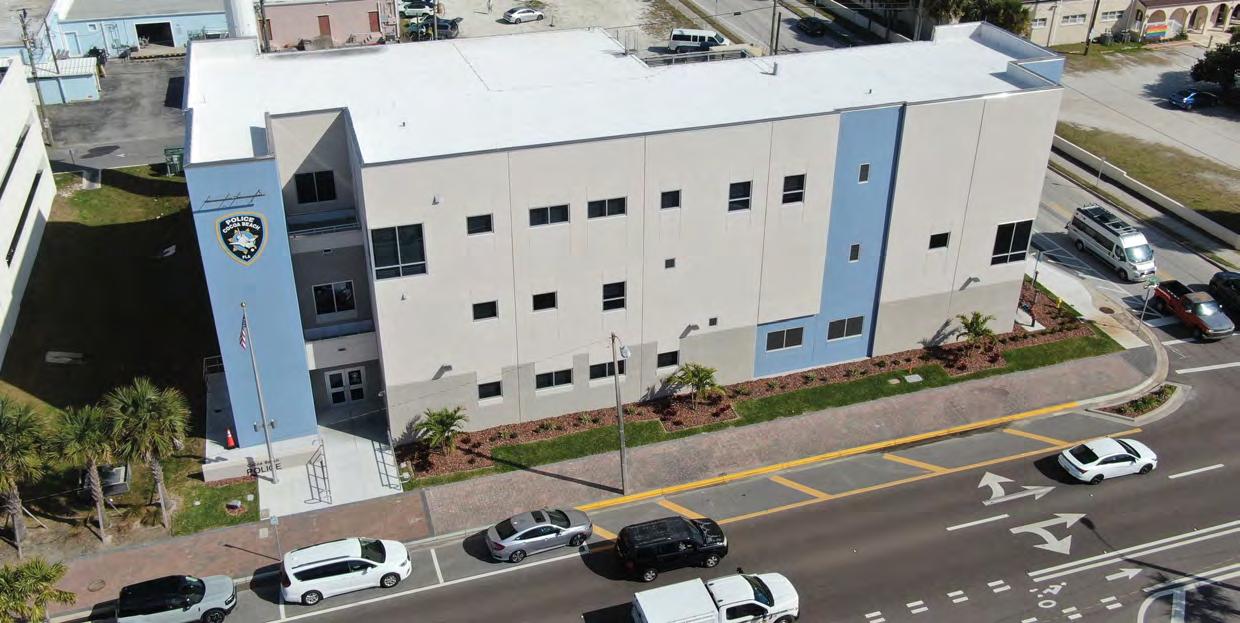
This award-winning station was designed to withstand the demands of a coastal community and stay relevant for decades to come.
SMI
Superior Rigging & Erecting Co.
Sutter Roofing
VMG Construction, Inc.
Member News is a forum for companies to share information with the Central Florida Chapter membership, free of charge. This service is available to all member companies on a first-come, first-serve basis, as space permits. Content should be editorial in nature, such as new contracts, finished projects, employee promotions, etc. and not promoting business products and services.
For more information contact Alssa Matthews at 407-628-2070 or send an email to: bcf@abccentralflorida.org
For detailed descriptions download the Media Kit from: abccentralflorida.com/media/building-central-florida/
Request an ABC Member digital logo by sending an email to: logorequests@abccentralflorida.org
… On September 30, 2022, former president and CEO Randy Brooks announced his retirement.
After 52 years of service, they say goodbye to a legend! In May of 1971, Randy was one of the first employees to join the AJC team. Before becoming president, Randy oversaw the daily operations, worked as a project manager, participated in the estimation of projects, and so much more.
Focused on continuing to build upon the company’s founding values and standards, maintaining repeat business through satisfied customers was a priority. “We do what we say we’re going to do,” says Brooks. This has helped AJC stay in the limelight with private business owners who procure their services time and time again. Randy’s impact on the company and the community is immeasurable.
Although saddened by Randy’s retirement, they are pleased that the legacy of over five decades and three generations continue to move forward under the leadership of Mike Moore, the new president, and CEO.

… 2022 was a lucrative year for Albu & Associates, closing in at nearly double what the firm made in the previous year!
A good portion of that is contributed to the work within the firm’s Target Remodel program. Albu has been providing general contractor services to Target since 2017. Each year, the number of projects the firm is awarded by Target grows. This year, Albu completed ten major store remodels as well as five minor upgrades. The minor upgrades consist of a continuation of the work Albu completed last year building out the stores’ order pick-up stations.
In addition, Albu gained new clients this year, one of them being SelfHelp Credit Union with two buildouts completed for them. The firm also completed the demolition of an existing restaurant in Clermont to make way for a new Miller’s Ale House and was responsible for the sitework as well.
Albu recently hired two new employees – an assistant project manager and an HR specialist. This is attributed to the growth of the firm’s workload. The firm is looking for additional new hires as well.
… Debbie Rodriguez’s motto is “Whatever it takes.” Over the last year, she and her team have been doing just that to ensure both CEP and the construction industry have come out on the other side of the pandemic.
The CEO of Competitive Edge Partners was recently rewarded for that work by the Orlando Business Journal as one their 2022 Power Players.
The Power Players Awards highlight 50 leaders in Central Florida who have helped grow and innovate the way business is done. This
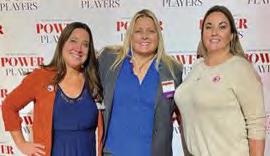
year’s list includes the president of the University of Central Florida, the mayors of Orange County and the City of Orlando, CEOs of major attractions, hospitals and more.
“It is a true honor to be listed among these impressive people,” Rodriguez said. “I firmly believe that there are people out there who are often overlooked and who, with support and training, can build an amazing life in the construction industry. I’m proud that with my incredible team, we’ve been able to build pathways to success and help our industry. I couldn’t have done it without my team’s support.”
The awards honor established leaders and up-and-comers in Orange, Seminole, Osceola, Lake, Brevard, and Volusia counties. Nominees are judged in five categories: industry giants, disruptors, deal makers, connectors, and heavy hitters.
Rodriguez was nominated as a connector for her role in bringing people together and keeping connections close to accomplish important goals.
Comprehensive Energy Services, Inc.
… under contract with Oelrich Construction, is nearly complete with the retrofit of a facility in Kissimmee owned and operated by the Florida Department of Agriculture and Consumer Services. This high-tech project result will be a safe BSL-3 laboratory for the state.
BSL-3 laboratories are used to study infectious agents or toxins that may be transmitted through the air and cause potentially lethal infections.
This year-long project includes:
• One new 120-ton air-cooled chiller
• One new custom RTU with energy recovery
• New chilled and heating water pumps, piping, and appurtenances
• 14 Phoenix air valves
• Two high-plume exhaust fans
• Welded stainless steel exhaust and galvanized supply ductwork
• A new Distech HVAC control system




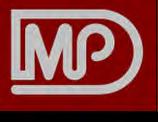



Insulation, test and balance, commissioning, and concrete foundations were all part of this scope of work. It was a challenging project to work in an access-controlled operational facility and integrate new work into adjacent buildings without disrupting operations.


Owners, developers and general contractors get a lot of notoriety for construction projects, especially in these infrastructure-focused times. However, the subcontractor is truly the one under the microscope, as this group requires the most care and attention to ensure the owners and operators are able to meet accelerating demand and public expectations.
The challenges in the current environment are many. Inflation and supply chain disruptions are highly detrimental to specialty trades in the mechanical, electrical, plumbing, drywall and other areas. Reports show that the construction industry, in particular, has seen an increase of over 20% in the cost of supplies and building materials in the last year alone and, in some cases, over 90% since the start of the pandemic. While these costs are passed along to the owner, the subcontractor still retains significant cash flow risk. This truth is amplified in a volatile market. As if the cost was not enough, equipment and material shortages coupled with rising interest rates only compound the problem—and tenfold for small businesses.
is proud to announce its 15th year in business. Over the past 15 years, Safety Consultants USA has grown from one safety consultant to over 25 who serve clients across the nation.
This growing team of advisors and instructors are some of the most experienced and educated in the USA. With their expertise in safety training and OSHA safety and health programs, their clients have the confidence and time to manage other company priorities.
Plans are underway to recognize SCUSA team members who partner with clients to provide them cost-saving employee safety training, custom safety solutions, and proactive OSHA compliance.

… Brian King, president and CEO of Westbrook Service Corporation, became just the third majority owner since the company’s founding in 1949. Brian and his team have dedicated themselves to creating a company culture that is so profoundly different that it leaves a lasting impact on the lives of Westbrook employee’s and their community. They have accomplished this by creating stability for the team in a way not often seen in the construction/service industry through competitive pay, consistent hours, low health insurance premiums/deductibles, eight paid holidays and annual bonuses.
The company has also prioritized carrying out Westbrook’s company culture into the surrounding community and beyond by using Westbrook’s resources to volunteer with local and global nonprofit organizations like No Child Hungry. Within his time as majority owner, Brian has successfully unified a once divided company through positive culture and values, instilling a sense of teamwork and camaraderie that is visible in Westbrook’s work.
Subcontractors are likely to feel the greatest pressure from supply-related issues. Inflation combined with supply chain shortages require subcontractors to prepare earlier for projects and, when possible, purchase materials upfront. However, the consequence of this preliminary preparation equates to further strains on cash flow. In an effort to remain aligned on schedules and budgets, subcontractors frequently buy all of a project’s materials as soon as a contract is signed—if not before.
It’s a huge cash expenditure for a segment of the industry that is notoriously cash poor; it’s common to see a subcontractor with over $100 million in annual revenue struggle to make payroll. The response from the subcontractor has been to take on more projects, each bleeding into the subsequent one and paying for its equipment and materials. The risks are high if those payments are in any way delayed—and a big reason why studies reflect contractors failing more often in good times than bad. Without cash, subcontractors have to use business savings, lines of credit or even personal savings to get projects moving forward.
Continued on page 32
Since


the most challenging jobs completed efficiently, safely and with high quality and value. From 3D modeling to Lean Construction, we work with your team to minimize uncertainty, reduce risk, eliminate waste and maximize the greatness of your project.


ABC Central Florida recognized the outstanding projects built by Central Florida Chapter members at the annual awards banquet held at Hilton Orlando on October 22, 2022. The 2022 Chair Chris Evans, Brasfield & Gorrie, LLC, and EIC Awards Committee handed out 99 Eagle Awards on stage along with a few special awards announced that evening with an audience of over 900.
This premier construction industry competition, established in 1988, honors the most prestigious construction projects and work in Central Florida. This year 74 companies submitted 155 entries. ABC’s special awards included the Free Enterprise Award, given to one general contractor and one subcontractor, for utilizing the most ABC Central Florida members on any one project promotes members doing business with members.
Another special award recognized marketing individuals who put together creative presentations for the EIC Awards judges. The Excellence in Marketing Awards were presented to Heather Gorney, Energy Air, Inc. and Shawn Straight, H. J. High Construction Company. The top honors go to the Project of the Year winners – one general contractor project is awarded for the entire project and one subcontractor project is awarded for their specialty work.
Check out the EIC Awards magazine for the complete list of award winners: abccentralflorida.com/abc-events/eic-awards/
2023 EIC Awards Schedule
January - February
Submit Survey to Compete
Request Permission to Enter Universal, WDI, WDW Projects
March 10 & 29, April 20
Soaring into Excellence -EIC Workshops
April 30
Entry Submission(s) Due
May 15
STEP Applications Due
June 16, 21, 23, & 29
EIC Project Entry Judging; On-site Tours & Presentations at ABC
October 14
Excellence in Construction Awards Banquet at Hilton Orlando, Destination Parkway
SUBCONTRACTOR
Dr. Phillips Center for the Performing Arts - Phase 2 KENPAT

GENERAL CONTRACTOR
Orlando International Airport South Terminal C Airside Hensel Phelps

GENERAL CONTRACTOR Balfour Beatty Lake Nona Wave Hotel

22 ABC Member Companies












October 27, 2022
Nearly 200 ABC Central Florida members attended ABC on Tap at Krush Brau Park joining 2022 VIP Premier Sponsors: KHS&S Contractors, S. I. Goldman Company, Inc. and WELBRO Building Company.





This FREE workshop is designed to help new, existing, and future ABC members learn how to utilize their membership for maximum effectiveness and return on their investment. Scan the QR code to sign up today!
November 17, 2022
Despite rescheduling due to Tropical Storm Nicole, this year was the biggest turn out at Apopka Amphitheater with 30 competing member teams, 13 of which were brand new to the competition! Thank you to all the teams for connecting and sharing their love for chili with ABC members.


Judges’ Choice Award — Best Chili

AJ Flooring
Williams Company Management Group
Guignard Company
People’s Choice Award — Best Chili
Acousti Engineering Company of Florida
Williams Company Management Group

Fender Marine Construction, Inc.
Best Themed Booth
AJ Flooring
WELBRO Building Corporation
Acousti Engineering Company of Florida

Spiciest Chili Award
Balfour Beatty
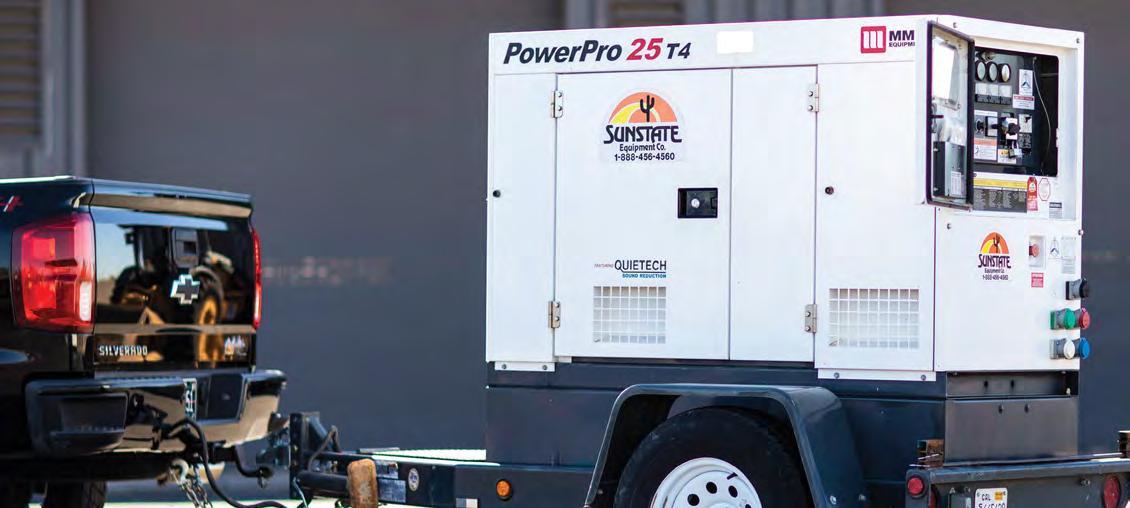


December 1, 2022
For the past three years, Terence Curran, chief operating officer at The Amphibious Group, has put together a charity Christmas parade. He goes to four communities collecting toys and food to donate to a local group in Orange County, FL. Last year his efforts collected $3,000 worth of toys for kids, $1,000 worth of dog and cat toys, and $25,0000 of food.

This year ABC CF partnered with The Amphibious Group to fully support local community efforts that impact the areas in which ABC membership serves. The holiday party was held at Gatlin Hall Brewing. Terence and his team exceeded the toy donation goal of $10,000 with the chapter’s dedicated members and their support!


flexibility” during downturns, one respondent observed. Earlier research by Tummalapudi also showed that surety bonding companies focus disproportionately on financial stability when choosing whether to underwrite projects. And, of course, a strong cash position helps companies recover faster.
But several of the highest-rated strategies centered on strengthening and maintaining ties with owners, bankers, sureties, CPAs, vendors, customers and subcontractors. One financial officer pointed to the role of company culture in retaining valued employees during tough times. For their part, the researchers encouraged contractors to engage in “honest, forthright discussions with bankers, CPAs, lawyers and surety agents … hiding true financial conditions can damage those relationships.”
While the nine highly effective strategies elicited the broadest consensus, differences of opinion related to contractors’ varying needs and perspectives could account for the moderately effective rating of the remaining 31 strategies.
Indeed, some of those moderately effective strategies could be workable options depending on the contractor’s size, financial resources, cash position and other fundamentals.
An estimated 92% of the 850,000-plus U.S. construction companies have 19 or fewer employees and annual revenues of less than $36 million, according to the paper. But larger construction firms that bring in annual revenues of at least $200 million tend to be more resilient, the researchers note. Greater capital reserves and access might also allow these larger companies to avoid recession strategies with costly downsides, such as bidding on low-profit jobs.
As explained in the paper, when contractors drop fees to “buy work” in this way, the goal tends to be to maintain cash flow, keep projects rolling and retain personnel. Some contractors may even try to “find” that missed profit by submitting more change orders.
While Tummalapudi and his coauthors caution that taking low-profit jobs “creates chaos and has significant repercussions,” some of the respondents appeared to be open to this approach. Indeed, one advised contractors to “reduce profit margins as necessary to maintain a reasonable backlog of work.”
In response, a surety participant commented that “buying work is a precursor to failure; it never works.” Based on the ratings, though, the 61 respondents were divided on this point: Only a slight majority, 52.6%, down-rated the idea of pursuing lowmargin work to stay busy.
This divided opinion makes sense, given that the respondents hailed from companies of all types and sizes. Similarly, another
common strategy during downturns—laying people off—may be more avoidable for some firms than others. As observed in the paper, layoffs can help companies survive but tend to be costly over the long term. Thousands of laid-off construction experts left the industry for good during the Great Recession and its aftermath, a contributing factor in historic labor shortfalls that continue to this day.
Additional “moderately effective” strategies covered in the paper related to areas such as:
• adopting Lean construction;
• selling underused assets;
• restructuring equipment and capital loans to turn equity into cash and reduce the burden on monthly equipment debt payments;
• seeking advice from mentors;
• training employees and managers to watch expenses;
• ramping up supply-chain and operating efficiency;
• retaining talent by formulating creative incentive and compensation plans, such as reducing the base wage and increasing bonuses;
• cutting back on non-essential expenses such as travel, meals or consulting; and
• confirming all financing on private jobs prior to signing contracts.
In their conclusion, the authors offer some additional advice, such as paying more attention to economic trends and principles and avoiding situations that could overextend the company’s capacity.
On this latter point, many contractors responded to the Great Recession by trying to diversify and pursue wholly new markets and verticals. But doing this during a downturn, the researchers contend, “is risky and often leads to failures … the time to diversify markets is during sustained growth periods and while the company has cash reserves to invest in the costly learning stage.”
Ideally, the U.S. construction industry will be able to dodge a severe or protracted recession in coming months—along with the onerous risks that can include, as noted in the paper, “cash-flow problems, legal disputes, low-profit margins and marketing difficulties.”
But as construction veterans know, the prudent course is to prepare for a downturn—a message that is particularly important for newer companies that have never been through a recession. As Tummalapudi and his colleagues see it, all construction contractors can bolster their odds of surviving and thriving by “adopting a mix of effective strategies that mitigate the risks associated with economic cycles.”

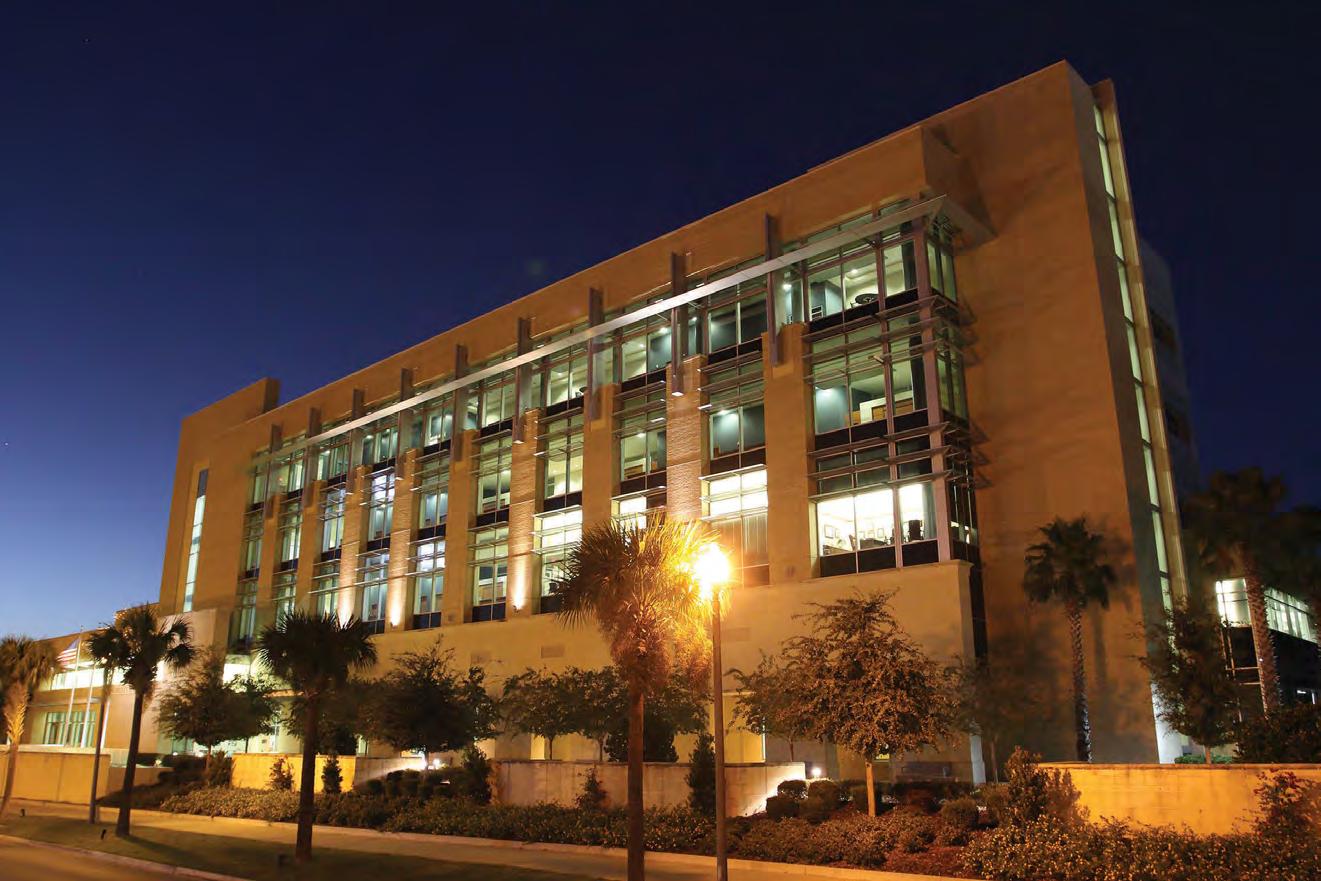





Members of ABC from across Florida came together in July 2022 at the Annual State Convention to deliberate critical issues of concern to the construction industry. These five subject areas are where legislation will be filed, and attention focused for the 2023 Legislative Session in Tallahassee.

ABC will work to ensure public entities are not limiting who can bid on projects by imposing project regulations that favor the few over the many. Also, to make sure public owners pay in a timely fashion to ensure that companies are not put out of business simply trying to run their business. Additionally, to make sure that the regulations imposed are consistent and predictable so that companies know well in advance of submitting a bid, what the expectations for the projects are.
Permit fee schedules should be clearly posted and easy to determine. They should not be subjective or based on things that have nothing to do with the level of service required during the duration of a project. Revenues and revenue surpluses should be reasonable and where they are not, fees should be reduced, or services should be dramatically improved.
ABC will work in tandem with fellow industry partners to secure critical reforms to cut back on abuse of this process.
Despite the great work with the DeSantis Administration to highlight the importance of strong workforce education offerings in Florida, there is always room for improvement. Funding needs to be increased and needs to be offered in separate silos for workforce education programs and apprenticeship training. Grant funding should also be made available to sustain or expand existing programs, and not simply just to start new ones. ABC will work to ensure that college credits are automatic and not left to the discretion of individual schools. ABC will also request a repeat of the “Tool Time Tax Holiday” and will work with guidance counselors to ensure that information on industry job offerings becomes a constant in Florida K-12 Schools.
Florida is often referred to as one of the most litigious states in the nation. This has been seen with property insurance, where Florida accounts for roughly 8% of total property insurance policies nationwide but 78% of insurance lawsuits nationally. ABC supports the legislature taking a full and comprehensive look at identifying ways to decrease the litigious atmosphere of Florida so that residents and taxpayers are not ultimately left footing the bill for these lawsuits.
Join us in Tallahassee on March 8-9, 2023 for the Legislative Conference. For more information go to abceastflorida.com/events
Save the date for the ABC of Florida State Convention, July 20-23, 2023
Attend the ABC Legislative Hobnob on March 25, 2023, at Harry P. Leu Gardens
Get involved in the ABC Government Affairs Committee, by contacting Taylor Dupree by email: tdupree@abccentralflorida.org
Take Action – during session, we will be sending Action Alerts to you, asking that you help us contact legislators in support or opposition to upcoming votes. The more people who “Take Action” when we ask, the better we do at conveying the importance of the topic to the industry and Florida. The 2023 regular legislative session convenes on March 7 and runs until May 5.
Governor DeSantis shared a clear vision of his upcoming legislative goals when he was sworn in for his second term as Governor on Tuesday, January 3, 2023. Here’s a brief look at what we can expect to see this session:
• Record amount of tax relief
• Keep ideologies and trends out of public and higher education
• Increase in family friendly policies to make it easier to raise a family
• Law and order state with continued efforts to support law enforcement
• Protect Florida’s natural resources
• “Decline is a choice. Success is attainable. And freedom is worth fighting for.”




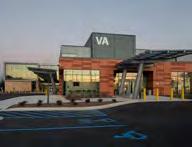
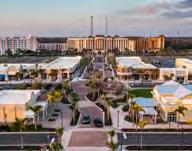
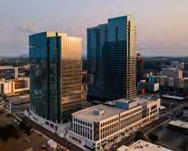



At the first session of ABC Central Florida’s 2022-2023 NEXGEN Leadership Program students were introduced to the leaders of the association: the board chair, officers, and directors at the monthly board meeting in September. Session two in October was held at Brasfield & Gorrie’s office where students discovered their strengths though the Clifton Strengths program and learned how to leverage them with instructions from Cyndi Gundy, President of CG Consulting and Leadership Consultant. Session three
Cyndi was brought in to teach the NEXGEN group guidelines about being a successful leader, accountability, and effective communication. She will be joining the program at a future session as well to discuss recruiting and interviewing strategies, and effective coaching and feedback strategies.
Continued from page 22
Options are few for this group, which is held responsible for meeting schedules and budgets while often being the last to get paid.
So what’s the answer? Subcontractors are a bellwether of industry success—it’s time to take better care of these essential partners.
One of the first areas of adjustment has been in the contractual terms between the general contractor and trade partners. The days of pay-when-paid, pay-if-paid, and similar contingency provisions are not going to cut it if the industry wants to maintain and strengthen the subcontractor supply chain.
Smart general contractors are having intense conversations with favored subcontractors to incorporate contractual terms that are agreeable for both parties. For instance, mobilization fees are working their way back into many contract terms. These fees help cover a wide net of provisions, including transportation, fuel, equipment rental, initial materials, tools as well as site prep activities. When provided in advance of a project start, mobilization advances can help maintain a subcontractor’s cash flow.
Now is also a good time for subcontractors to review retainage policies contracts. Reducing retainage is a great way to speed up cash flow.
For general contractors, assuring cash flow is often a balance between state regulations and availability. For example, contractor and supplier diversity requirements, especially on public projects, are expanding. In many states, payment terms for small-, minority-, women-, veteran- and LGBTQ+-owned businesses are set by law and can require weekly payments. This can cause general contractors to prioritize one group of subcontractors over another, exacerbating subcontractors’ risk of cash flow challenges.
The December session hosted by DPR Construction focused on ABC and mental health. Guest speakers included a past board chair and a current board director talking about the history of the association, its philosophy, and its role as the voice of merit shop construction. Students heard from Ashley Grimes, president of the National Alliance on Mental Illness, and Amber Addario, program director, Project Opioid, about real-life experiences about addiction and mental illness, ways to notice signs of distress, and how to use Narcan on the jobsite or in an emergency. Future sessions of the program will include meeting at Gray|Robinson, P.A. in Orlando to discuss public policy, law, and political advocacy where they will be joined by a panel of representatives from Shutts & Bowen, LLP; Kirwin Norris, P.A.; Dean Mead Attorneys at Law; as well as Carol Bowen, ABC of Florida’s chief lobbyist.
If you are interested in learning more about the NEXGEN Leadership Program, please contact Corey Schoenfelder at training@abccentralflorida.org. For more information on Project Opioid and Mental Illness please visit these websites: careersourcecentralflorida.com/forte projectopioid.org
namiflorida.org

When it comes to paying for materials, subcontractors can work closely with suppliers for longer payment terms. They can also borrow money from credit lines, which works, but will also put additional strain on the businesses if there’s a lull in project start times. Beware of rising interest rates, though. Investigating credit card cashback programs might be an option.
Receivables financing is another strong option. This method leverages an owner or general contractor’s credit position to pay subcontractors in days instead of weeks and months. It’s not a loan and, therefore, it’s not a debt. One of the biggest benefits is that it allows for much greater predictability around cash flow with no interest accumulation and fees that are much lower than conventional bank loans.
Some general contractors are even enrolling their favored subcontractors in a receivables financing program, and paying the associated fees, to strengthen subcontractor relationships and build trust.
Inflation, continued supply chain issues and even workforce shortages are real challenges—and contractors of all types and sizes are buckling up for a couple of tough years.
As the bellwethers of all trends, good and bad, subcontractors are essentially the heart of the construction industry. Their cash flow problems affect every facet of the industry, from the suppliers to the general contractors, owners and developers. The owners and general contractors that find a way to support and strengthen those project partners will see the greatest success in the next few years and beyond.
Reprinted from Construction Executive, September 2022, a publication of Associated Builders and Contractors. Copyright 2022. All rights reserved.
NEXGEN is absolutely a program worth keeping around… the interactions and lessons learned are second-to-none.
– Wes Harris, Baker Concrete Construction, Inc.




 By Ro Bhatia
By Ro Bhatia
The construction industry faces a major problem: Inflation is squeezing contractors and subcontractors.
• Overall inflation is causing the cost of everything to skyrocket, from food to fuel to office supplies and rent.
• Vital construction materials have seen some of the most volatile prices.
• Continued supply chain issues are still adding to the cost of materials.
• Overall economic uncertainty and fears of an upcoming recession are rising.
How these construction professionals address and resolve these challenges could be the difference between a bright future for their businesses or a continued rough road ahead.
Rising materials and other costs, such as labor, fuel and maintenance costs, are simply crushing contractors and subcontractors. The pandemic devastated supply chains across the globe, the U.S. homebuilding boom swallowed up lumber, concrete and other essential materials as fast as they could be produced and now rising interest rates are further impacting construction budgets.
Contractors and subcontractors are caught in a vise of rising materials costs, a serious and growing skilled labor shortage and ongoing supply chain issues that drive up costs and delay projects. For instance, the price of steel, a major component of data center construction, fluctuated dramatically, rising over 200% from March 2020 to mid-2021 before finally easing this summer. Other critical inputs have also risen. In fact, the cost of key building materials has risen 19.2% year over year and 35.6% since the beginning of the pandemic. Thankfully, supply chain bottlenecks that plagued the industry have eased, and some prices have even fallen, but contractors and subcontractors continue to face severe materials cost challenges.
Another challenge is rising fuel costs. For a subcontractor with a small fleet of three Ford F-150s, at $3.70 a gallon (the current national average), simply filling up those vehicles twice a week could
lead to over $2,000 a month in out-of-pocket costs. In key markets in California, the Pacific Northwest and across the eastern seaboard, those costs are as much as 35% higher. Increasing diesel prices are an even greater concern. In early 2022, diesel costs rose 33% in just five weeks, driving the price to an all-time high of $5.78 per gallon in June. According to EIA, diesel prices have jumped 141% since the pandemic began
The cost of construction materials is about 35% to 60% of the overall construction cost. For the last three years, record inflation has driven up the cost of construction projects while also creating new risk management challenges for contractors. The construction industry weathered the pandemic economic slowdown better than most industries, but significant barriers to success remain.
Inflation is so detrimental to contractors and subcontractors because of the nature of the industry. It leads to cash flow management problems, declines in sales volume, longer production timelines and exacerbates other construction operations challenges.
Contractors and subcontractors must purchase materials in advance of a project before they are paid. In most cases, they must pay for those materials within 30 days to 60 days of purchase, long before they are paid for their work. As costs rise, the holes in the budget get wider and wider. This jeopardizes the ability to bid on and win more contracts as the necessary cash flow simply isn’t available to float a new project.
While the $1.2 trillion bipartisan infrastructure plan signed into law last year has been hailed as a savior for the industry, it also creates additional problems. Funding for major new projects is increasing demand for scarce construction materials but does little to increase the supply of those materials, adding further inflationary pressure. As we all learned in high school economics, adding more dollars to chase too few goods leads to … greater inflation. It is a boon to the industry to know there will be a steady supply of funding for projects, but without real action to lower material and energy prices, costs will continue to rise and contractors and subs will continue to see narrower margins. In the end, ever-higher costs harm the bottom line, limit a project’s upside rate of return and are encouraging owners to delay the start of construction or cancel proposed jobs entirely.
Experts do not believe rising inflation and uncertainty will lessen over the next year. So how are contractors and subcontractors supposed to bid on and secure their next project while materials prices remain volatile and could easily cause a project to become unprofitable?
The first thing construction professionals must do is focus on solving what is within their control. Thankfully, innovative, simpleto-use preconstruction technology can provide greater control and productivity. These platforms improve planning, increase efficiency and help general contractors, subcontractors and suppliers collaborate more easily to establish long-lasting connections that enhance stability and success.
Preconstruction, the first phase of any project, is used to create strategic project plans, including design plans, check vendor qualification, establish communication with owners and source not only the needed materials but the labor to see the project through to completion. The most impactful digital tools tie all preconstruction information in one place, bringing contractors, subcontractors and suppliers together to share information, improve collaboration and reduce the time it takes on traditional processes.
According to a recent study, the construction industry is finally making implementation technology a priority. Over one-third of specialty contractors plan to increase investment in construction technology to streamline functions and improve productivity. Unfortunately, construction remains a relatively change-averse, “old school” industry, with 39% of specialty contractors reporting they still primarily use spreadsheets, whiteboards, paper-based processes, or other methods instead of construction tech platforms, with concrete contractors particularly lagging. And a PlanHub September 2020 survey of over 300 subcontractors found that 50% build their take-offs manually or offline.
The right construction planning and management solutions digitize all the information and paper contractors and subcontractors use most often. Instead of combing through old bidding documents, spreadsheets and Post-It notes, software solutions provide quick and easy document replication, streamline bidding and other critical processes and saving precious time and money. For example, digitizing estimating and materials takeoff tasks reduces the amount of time needed to complete proposals. The increased accuracy also reduces the chances of cost overages and makes for easier cash flow.
The technology is particularly helpful in the crucial bidding process. Easy access to documents and data helps create more detailed, accurate and speedier bids. The right applications also notify construction professionals about new projects in their service area and can help them place their bids ahead of the competitors and gain an advantage.
Of course, there is far more to an effective bid than speed or offering the lowest bid. Contractors and subcontractors need to build trust with project developers and showcase the attributes that make them a better fit than their competition. Integrated construction platforms allow construction professionals to complete extensive profiles of their businesses. They can create and save data illustrating their success, such as the completion of previous projects, safety records, licenses and much more. This provides potential clients with the full scope of the company’s true value and ability.
The digital revolution can help contractors and subcontractors maximize efficiencies, save money and mitigate rising inflation. By using innovative construction planning and management technology now, construction professionals can improve critical business functions, strengthen collaboration and be better prepared for the challenges ahead.

Reprinted from Construction Executive, November 2022, a publication of Associated Builders and Contractors. Copyright 2022. All rights reserved.

Acousti Engineering Company of Florida
Advanced Green Technologies, Inc.

Baker Concrete Construction, Inc.
Burr & Forman LLP
CEMEX
Comprehensive Energy Services, Inc.
DeWitt Custom Concrete, Inc.
Electric Services, Inc.
Energy Air, Inc.
Entech Innovative Engineering
GMF Steel Group

Guignard Company
Hensel Phelps
Hoar Construction, LLC
Kirwin Norris, P.A.
Mader Southeast
Maschmeyer Concrete
National Trench Safety, LLC
PCL Construction Services, Inc.
Power Bolt and Tool
Quality Metals, Inc.
RAMS RPG
S. I. Goldman Company, Inc.
Safety Consultants USA
Sasso & Sasso, P. A.
Sunstate Equipment Co., LLC
Tucker Paving, Inc.
SELECT Aagaard-Juergensen, LLC
American Pools and Spas
Austin Commercial Brasfield & Gorrie, LLC.

DPR Construction
ERC Provider
Fine Tune Enterprises, Inc.
J. A. Croson, LLC
JK2 Scenic
Mechanical Insulation & Technologies, LLC
Modern Plumbing Industries, Inc.
R. C. Stevens Construction Company
Robins & Morton
Sciens Orlando
SUBHQ
Terry’s Electric, Inc.
Tharp Plumbing Systems, Inc.
Titan Electric Souheast, LLC
Trade Management, Inc.
Universal Forming Waste Pro USA
CHOICE
Albu & Associates, Inc.
Certified Slings & Supply


Competitive Edge Partners & Consulting, LLC
Dean Mead Attorneys At Law
Hartford South, LLC
Lake Glass & Mirror, Inc.
LRA Insurance
Shutts & Bowen, LLP
Turner Construction Co.
Winter Park National Bank Withum
CENTRAL FLORIDA ABC